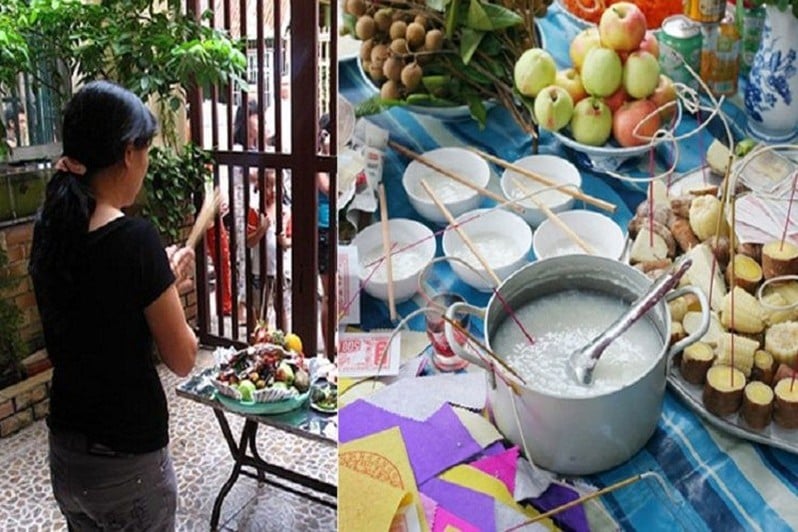The Hungry Ghost Festival is an important annual event, during which families offer sacrifices to their ancestors and perform various rituals.
So, which is the best day to hold the ceremony this year?
According to feng shui experts, the 15th day of the seventh month of the lunar calendar (August 18th this year) is considered the most auspicious day. The ideal time frames for the ceremony are: 7am-9am, 9am-11am, and 1pm-3pm.
Additionally, the following days are also suitable for the festival: August 14th (11th of the seventh lunar month) with time slots of 7am-9am, 9am-11am, and 3pm-5pm; August 15th (12th of the seventh lunar month) with time slots of 7am-9am and 1pm-3pm; and August 16th (13th of the seventh lunar month) with early morning and evening slots of 5am-7am and 3pm-5pm, 5pm-7pm respectively. It is believed that those born in the year of the Rooster, Horse, or Rabbit, as well as those whose birth year ends with the number 6 (e.g., 1966, 1976, etc.), should avoid performing rituals on this day.
Similarly, for the 14th of the seventh lunar month (August 17th), the preferred time frames are: 5am-7am, 9am-11am, and 3pm-5pm.
During the Hungry Ghost Festival, in addition to ancestral worship, many families also perform rituals for wandering spirits. These rituals are typically carried out during the seventh month, and experts recommend the time slot of 5pm-7pm. It is believed that the rituals should be completed before noon on the 15th of the seventh lunar month.

So, which is the best day to hold the ceremony this year?
What should be included in the offerings for the Hungry Ghost Festival?
For ancestral worship, a traditional feast is prepared, including dishes such as bamboo shoots soup, stuffed bitter melon soup, chicken, spring rolls, and various meats.
On the other hand, for the wandering spirits or ‘hungry ghosts’, only vegetarian dishes should be offered to prevent evoking greed. A typical offering for the hungry ghosts includes the following items:
+ A plate of rice and salt to be sprinkled on the pavement, at crossroads, or in front of the house in the four cardinal directions and four ordinal directions after the ritual.
+ Thin rice porridge.
+ 12 pieces of jaggery or brown sugar.
+ Five types of fruits of different colors.
+ Paper clothes and paper money.
+ Popped corn, boiled sweet potatoes, corn, and cassava.
+ Chopped sugarcane.
+ Cakes, candies, and small denomination banknotes.
+ Three small glasses of water, three incense sticks, and two small candles.
+ Clothes for the wandering spirits.
The ritual for the wandering spirits is usually performed outdoors or in front of the main entrance of the house. The host can recite invocation texts or pray according to their wishes. At the end of the ritual, rice and salt are scattered in the yard or on the road, and the ceremony concludes while the incense is still burning.

What should be included in the offerings?
Invocation for the Hungry Ghost Festival, adapted from “Văn khấn cổ truyền Việt Nam”, published by the Information and Culture Publishing House
Invocation for ancestral worship
Nam mô A Di Đà Phật! (Repeat 3 times)
We bow to the nine directions of the sky and the ten directions of the Buddhas, the ten directional Buddhas.
We respectfully bow to our ancestors and all the spirits.
We, the believers, are: …
Living at: …
Today is the 15th day of the seventh month of the year …
On this Vu Lan festival, which coincides with the Mid-year festival, we remember our ancestors, grandparents, and parents who gave birth to us, built our family, and laid the foundation of our humanity, allowing us to enjoy their blessings today.
We are deeply grateful for their immense grace and kindness. Thus, we, the believers, have prepared offerings of fruits, flowers, tea, gold, and silver, and now light incense to sincerely offer our respects to our ancestors: Cao tang ancestor, Cao tang aunt, uncles, brothers, sisters, and all the spirits in our family, both direct and collateral lines of the … family.
May you bless and witness our sincerity, accept our offerings, and protect us so that we stay healthy and peaceful, prosperous and fortunate, and so that our family thrives and follows the right path.
Our offerings may be modest, but they are presented with utmost sincerity. We bow before you and ask for your blessings and protection.
Nam mô A Di Đà Phật! (Repeat 3 times)
Invocation for the wandering spirits during the Hungry Ghost Festival
Nam mô A Di Đà Phật (Repeat 3 times)
We bow to the nine directions of the sky and the ten directions of the Buddhas, the ten directional Buddhas.
We bow to the Buddha of Infinite Light.
We bow to the Bodhisattva of Compassion.
We bow to the God of the Stove and the God of the Land.
As the seventh month approaches the autumn equinox
The fifteenth day is for pardoning the hungry ghosts
The gates of the underworld open
For the homeless and rootless spirits
Great Saint Kieu Giao – Ananda, the honored disciple
Receives the wandering souls without graves or tombs from all directions
From under trees, by the roadsides, in markets, and in alleys
Rootless and homeless, they wander day and night
Enduring cold and hunger throughout the year
Without a thin layer of cloth to shield them from the chilly wind
Hungry ghosts from the north, south, east, and west
Young and old, gather here
Now, hearing our invitation
Please come and enjoy the offerings prepared for you
Rice, porridge, betel, and areca
Gold and silver, clothes of various colors
Rice, fruits, flowers, and lanterns
Take some with you for tomorrow
And bless us with prosperity and peace
Remember the day of pardoning the hungry ghosts
And come again when we invite you
Now that you have enjoyed the offerings
Please return to the underworld, both young and old
We, the believers, burn gold and silver
Along with clothes that have been distributed
We respectfully inform the deities
And ask them to witness our deeds
For us, the believers
Name: …
Spouse: …
Son: …
Daughter: …
Living at: …
‘Money Tree’: Plant This Tree in Front of Your House and Watch Your Wealth Grow Like Never Before
This is a highly popular plant, beloved by many and commonly found in homes and offices alike. With its vibrant green leaves and sturdy stems, it’s a hardy and attractive addition to any indoor space. Its popularity is due in part to its low maintenance needs and ability to thrive in a range of environments, bringing a touch of nature and a pop of color to any room.



































